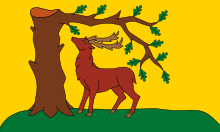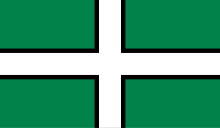User:TheCyberDragon/sandbox
Flags of the Counties of the United Kingdom
[edit]The galleries below show flags attributed to the counties of England, Scotland, Wales and Northern Ireland, with the Date of Adoption written in brackets This includes flags registered by the Flag Institute.
Historic Counties of England
[edit]| Flag | County | Adopted | Design |
|---|---|---|---|
 |
Bedfordshire | September 2014 | The design of the flag is a composite of several symbols significant to the county. In heraldic terms the design is Quarterly Or and Gules a Fess wavy barry way of four Argent and Azure surmounted by a Pale Sable charged with three Escallops of the third.
The yellow and red quadrants (Quarterly Or and Gules) are taken from the arms of the Beauchamp family, powerful in the county after the Norman conquest of England and constructors of Bedford Castle. The blue and white wavy lines (a Fess wavy barry way of four Argent and Azure) are symbolic of the Great Ouse, which flows through the county, including the county town of Bedford. The three vertically-arranged shells (or scallops) on a black panel (a Pale Sable charged with three Escallops) are taken from the coat of arms of the Dukes of Bedford |
 |
Berkshire | 2 March 2017 | The flag features a traditional symbol of the county, the stag and oak. This design's connection with the county dates from at least Michael Drayton's 1627 poem Battle of Agincourt, where he describes the men of Berkshire marching under the symbol of "a Stag, under an Oake that stood". The stag has twelve-point antlers (characteristic of "royal stag" red deer), a reference to the county's title as the "Royal County of Berkshire". The stag and oak together represent the county's forestry and deer herds. The Flag Institute considers the design to be "traditional" |
 |
Buckinghamshire | Ancient | This is the traditional flag of Buckinghamshire which features a chained swan (The Bohun swan) on a bicolour of red and black, taken from the arms of Bucks. The swan emblem dates back to Anglo-Saxon times, when Buckinghamshire was known for breeding swans for the king. The Bucks swan appears on the arms of some of the historic towns in Buckinghamshire, such as Aylesbury, Buckingham, Chesham, Marlow and High Wycombe. |
 |
Cambridgeshire | 1 February 2015 | The three gold crowns represent East Anglia, with wavy light blue lines representing the river Cam in the colours of Cambridge University on a dark blue background. |
 |
Cheshire | 10 April 2013 | On the flag are three golden sheaves of wheat and a golden blade on a blue background. The design has been associated with the Earldom of Chester since the 12th century, and has been used in the coat of arms of Chester since at least 1560. |
 |
Cornwall | 19th Century | St Pirran's Cross, a white cross on a black field. |
 |
Cumberland | 13 December 2012 | The flag is based on the pattern of the arms of the former Cumberland County Council, originally granted by the College of Arms on 19 September 1950, namely:
Per fesse vert and barry wavy of six Argent and Azure in chief three Parnassus Flowers proper. The Parnassus flower is a wild flower of the marshy uplands and was chosen as the county flower of Cumberland, growing here on a green field. The wavy blue and white stripes in base represent the coastline and the famed lakes of the county. |
 |
Derbyshire | 2006 | Green cross on blue background with gold Tudor Rose in the centre |
 |
Devon | October 2006 | The green represents the colour of the rolling and lush Devon hills, the black represents the high and windswept moors (Dartmoor and Exmoor) and the white represents both the salt spray of Devon's two coastlines and the China Clay industry (and mining in general) |
Ceremonial Counties of England
[edit]While the flag institute doesn't register flags of Ceremonial Counties, there are unofficial flags which have been used to represent them.
| Flag | County |
|---|---|
 |
Cumbria |
 |
East Sussex |
 |
Greater London |
 |
Greater Manchester |
Historic Counties of Wales
[edit]| Flag | County | Adopted | Design | Coat of Arms |
|---|---|---|---|---|
 |
Anglesey | March 2014 | The design is a banner form of the coat of the arms ascribed by later medieval heralds, to the earlier, locally celebrated Welsh Lord Hwfa ap Cynddelw of Llifon and a steward to Owain Gwynedd Prince of the Welsh. The earliest reference to the arms seems to be in the work of the bard Lewys Glyn Cothi from the period of 1447 to 1486 although there is no evident explanation for the choice of colours or charges used. A late c. 15th-century stained-glass window with the arms referring to Hwfa are apparently depicted in the east window of Llangadwaladr church on the island. According to the heraldic historian Wilfrid Scott-Giles, Anglesey County Council used the Hwfa arms informally before they were incorporated into the design granted to them officially. Between 1857 and 1950 the arms were used by Anglesey Constabulary. An association between the Hwfa arms and the island county of Anglesey is thus long established. | |
 |
Caernarfonshire | March 2012 | Owain Gwynedd was born around 1100 and became King of Gwynedd in 1137. In 1415, the Battle of Agincourt was fought in which the Caernarfonshire units were reputed to have fought under a banner of three golden eagles on green in honour of Owain Gwynedd. Michael Drayton records this in his work The Battaile of Agincourt in 1627.
In his 1920 work on county identities Story of the Shire, Frederick Hackwood calls the three golden eagles of Caernarfonshire as an "authentic" and "significant" badge of the county, as well as reciting their association to the Romans of antiquity |
|
Proposed flags of Counties of the United Kingdom
[edit]| Flag | County |
|---|---|
 |
Brecknockshire |

